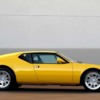Set your camera for the largest possible picture size and best possible picture quality. Use every megapixel you paid for.
If you have one of those SLR type rigs, use a tri-pod to stabilize the camera and get the most of the sharpness and resolution those cameras are capable of.
Good photographers spend lots of time setting up each photo; getting the car(s) parked just perfect, getting the camera positioned just perfect, getting the lighting perfect. Attention to detail pays big dividends. A photo journalist on the other hand just makes the best of each situation. The photographer I like to use, Mark Fechser, has a great blend of both qualities. He can take a fussy, perfectionist photo as well as anyone, but he can roll with the punches at a car show or track event too.
Dave is right that in general cars photograph best from the level of the belt-line and from a ladder or high position. Photos taken standing up, 5 to 6 feet above the ground, are the least flattering.
When shooting outdoors in the daytime, and if I have the time, I like to take two photos of every angle, one with flash and one without. Doesn't matter if its sunny or overcast. The flash may eliminate a shadow, and generally doesn't create any new problems. If I'm snapping pictures rapidly I may miss seeing a shadow problem before I snap the picture. Shadows can ruin an otherwise gorgeous picture. The extreme tuck-under of the Pantera's coachwork is especially bad at disappearing into the shadows. Automatically taking pictures with and without flash fixes problems I didn't see at the time I snapped the picture, it also allows me to compare the results and gives me choice.
Overcast & foggy days suck. That's generally what we have to work with in Monterey about half the time.
If you're using a model, have the model posed looking at the car, as though they are admiring it. This focuses attention on the car and not on the model.
Another benefit of early morning photo shoots, there's fewer interruptions, autos or pedestrians, getting into the frame.
On the downside ... you have to deal with long shadows thrown during those early morning and late afternoon photo shoots. The pro's have the reflectors and shades they can use to control the lighting on their subject ... you and I usually do not. Shadows are the enemy when it comes to auto photography, unless you're being creative and using shadow for dramatic effect.
On the subject of back ground ... verticle lines and objects (like trees or light poles) really detract from a picture. But you can't always find the perfect place or perfect angle with a perfect background. Thats where photoshop comes in. See how the picture below has been edited from the original.
-G
PANTERA INTERNATIONAL
A DE TOMASO CAR CLUB
Presents the De Tomaso Forums
The On-Line Meeting Place for De Tomaso Owners and Enthusiasts From Around the World
Clicking on the banner will take you to the sponsor's website.


